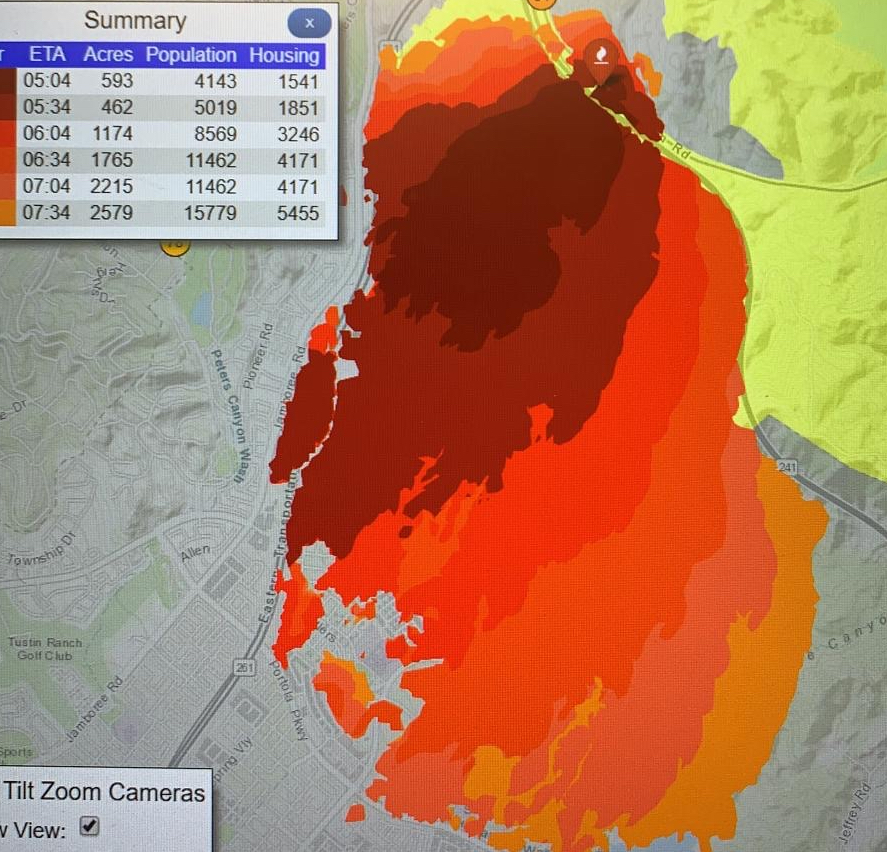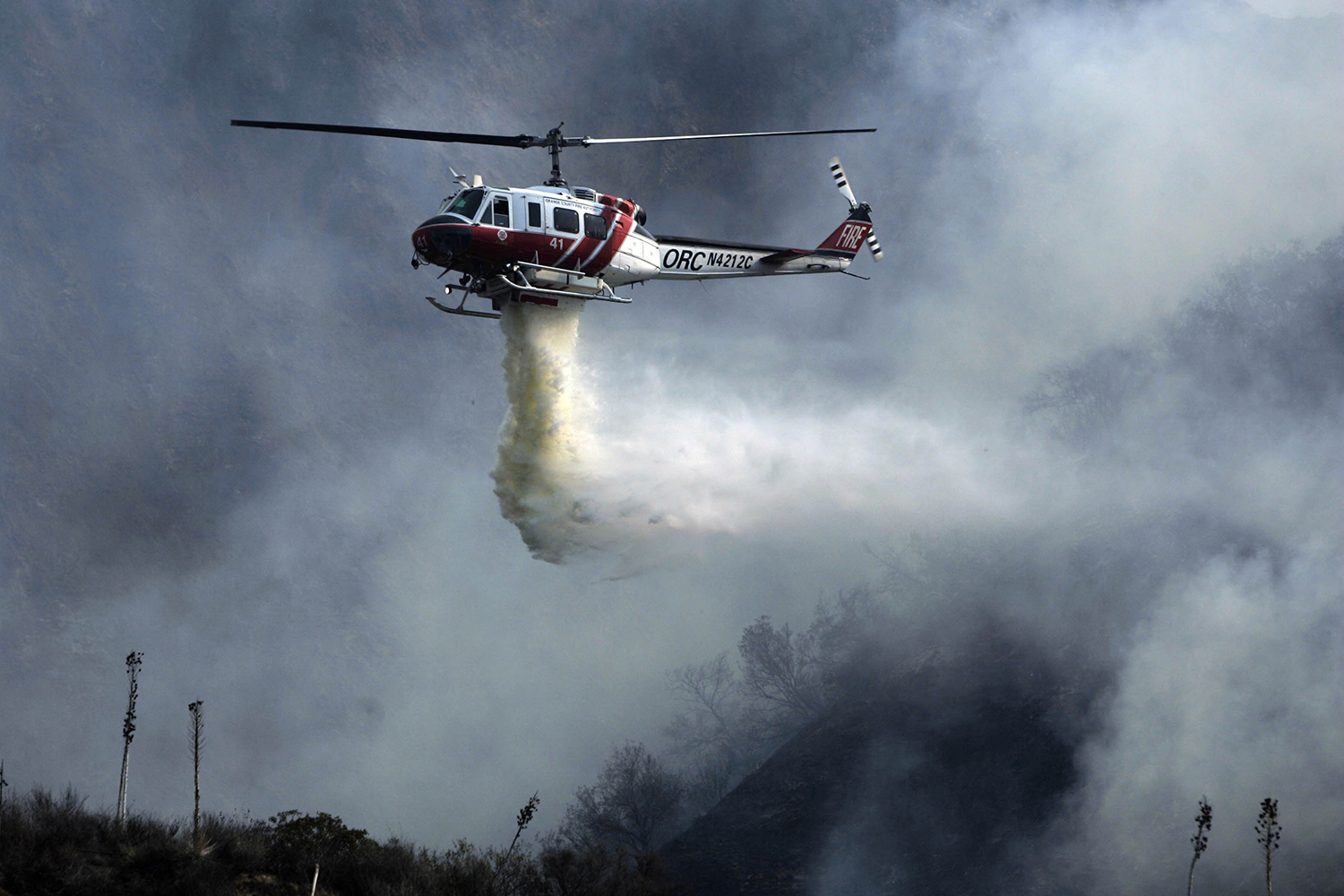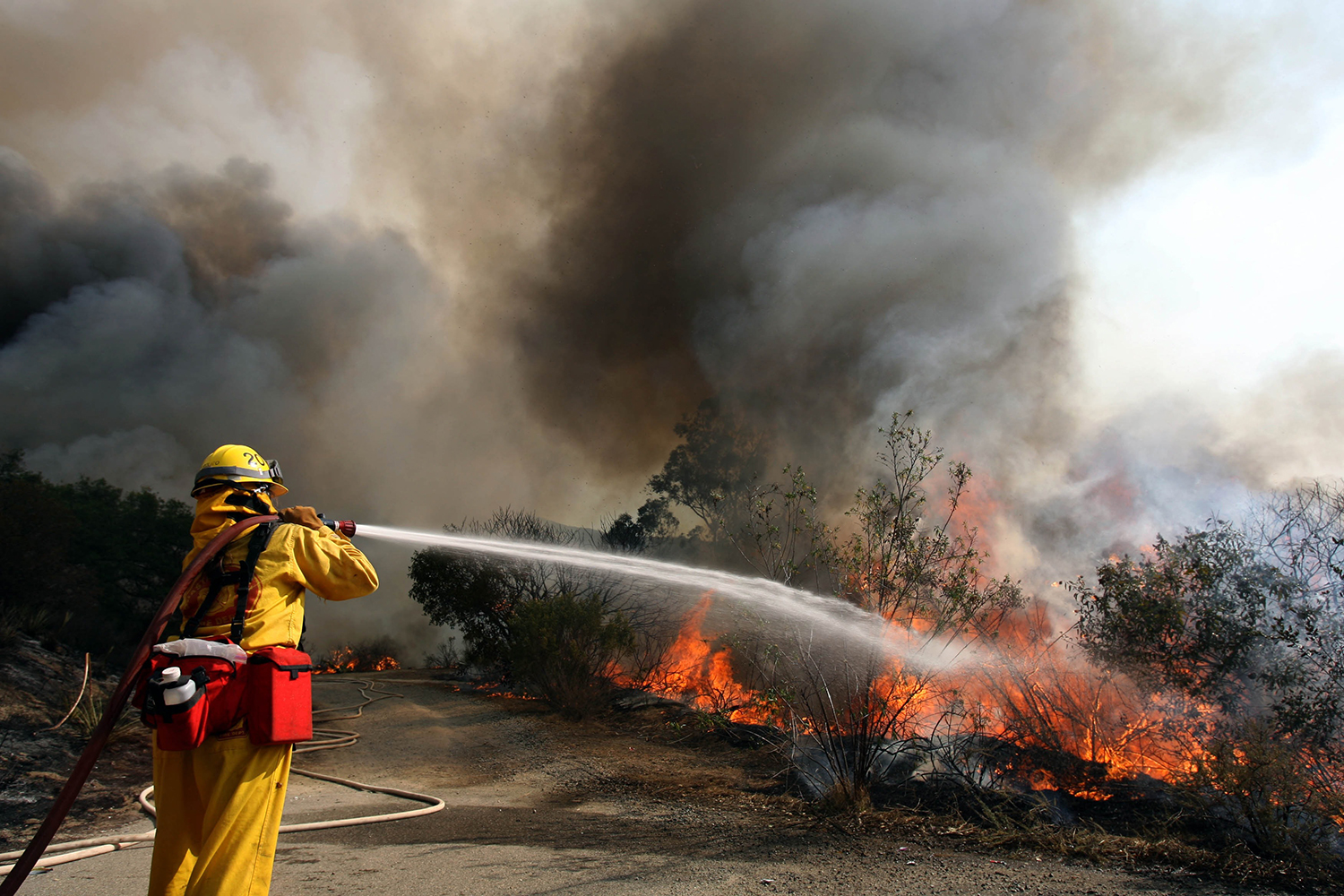
In the middle of the night last October, a suspected drunk 26-year-old rammed his Toyota Corolla into a power pole, shearing it in half. An off-duty California sheriff, who was driving on the same stretch of Orange County’s Santiago Canyon Road, saw the resulting fireball in his rearview mirror. By the time the sheriff made it to the wreck site with a fire extinguisher, the driver had already been helped out of the Toyota, but the car’s explosion had scorched the brush on the side of the road, and the embers were quickly climbing up the hill. If the fire jumped over the highway, more than 4,000 people would have to be evacuated and 1,500-plus homes would be in its path.
As with the Santiago Canyon incident, most wildfires start with human technology, like the heat from a car fire or the spark from an electrical wire. The 2018 Camp Fire — the deadliest fire in California history, which took almost a year to completely contain — was caused by a 100-year-old electrical transmission line. The 2018 Ferguson Fire, which burned in three different forests and caused over 118 million dollars in damage, began with a vehicle’s faulty catalytic converter.
Climate change has also made summer longer and winter and spring shorter. The American wildfire season used to last from July to October, but now the season extends well beyond those months. Shifting weather patterns have also increased the amount of wind, making wildfire flames hotter and less predictable. Plus more developers are building in areas that were once secluded woodlands, which means more lives and buildings are lost. The successful battle against the Santiago Fire demonstrates how the upcoming fire season may be fought differently than previous ones.
Fighting fire with FIRIS
A couple months before the Santiago Canyon Fire, the Orange County Fire Department (OCFD) launched a pilot program for a new firefighting tool dubbed FIRIS: the Fire Integrated Real-Time Intelligence System. The FIRIS team responds as soon as the report of a blaze comes in, deploying a plane to map the perimeter of the flames, sending a real-time stream of the hot spots and, using artificial intelligence, forecasting the speed and direction of the spread.
“We were just as concerned as heck,” recalls Orange County Fire Chief Brian Fennessy about the Santiago brushfire. “We had the potential for thousands being in the path within an hour.”

The fire department dispatched a crew to the Santiago Canyon at 3:44 a.m, and it arrived 12 minutes later. By that point, the flames covered about half an acre.
The Santa Ana winds gave the outbreak plenty of oxygen to grow. “If you time a five-acre fire for one minute, it’s not 10 in two minutes, it’s 18,” says Joel Lane, who was flying in a helicopter over the fire that night. “Three minutes, it’s 47. Five minutes, it’s over 100 acres.”
Lane’s helicopter was equipped with an infrared camera, which captured the firebrands showering over the freeway. If the flames bridged the road, more equipment and first responders would need to be called and the firefighters would have to focus on protecting structures and lives in addition to the wildfire.
The fact that it was a Thursday night complicated things even further. Workweek evacuations are tricky. In a few hours, commuters would be heading out, school buses would be picking up children, and any freeway rerouting would come with exasperated drivers and loud horns.
“Firefighters get slower as a fire gets larger,” explains Lane, who has been pushing back blazes for 40 years. “And that happens an exponential rate.”
Flying above Lane was a fixed-wing plane capturing data for the FIRIS system. Information about the intensity of the fire and the moisture level of the plants was relayed back to the University of California, San Diego (UCSD), where a supercomputer using the FARSITE program analyzed the slope of the hill, the wind speed, and other weather conditions that might come into play. The program estimates how the fire will grow in 30-minute increments.

Across the United States, several fire departments have similar fire behavioral software that utilizes pictures taken from satellites and mountaintop cameras, but few have such real-time analysis. Years ago, a fire company’s incident commander (IC) might have stared at one side of the Santiago Canyon Fire and spitballed about the resources needed to contain the inferno, never knowing what was happening on the other side of the ridge.
“What sets the FIRIS system apart is that we’re physically standing by with a firefighting aircraft for an initial attack,” explains Fennessy. The information from UCSD is then relayed to an IC on the ground via cell phone visual, who has discussions with the experts flying above. During the Santiago fire, FARSITE estimated that by 5:04 a.m. the blaze would cover 593 acres and impact a population of 4,143 and 1,541 houses. By 6:04 a.m., those numbers would grow to 1,174 acres, 8.569 people, and 3,246 houses. The information also included suggestions on where and when to evacuate local residents.
Early on Thursday morning, the IC decided to attack the Santiago Canyon Fire from above with two water-dropping helitankers, which can rain up to 1,000 gallons of H2O with each delivery. They’re supported by several responders on the ground. Lane figured that if the fire lasted beyond sunrise, when the temperature of the air and plants would both increase, an extra four helicopters, four helitankers, and an attack plane would also be needed.
Hit it with everything you have
“The whole strategy is to hit it hard with everything you have,” explains Fennessy. “Because if you get outside that initial time window, the fire becomes so big now you’re going to need a lot of other help.”
In the past four decades Fennessy has been a firefighter, wildfires have become a lot more intense. California’s numerous years of drought have created a lot of “fuel” that hasn’t been washed away by recent rains. Between 1927 and 2013, the amount of burnable land doubled worldwide.

Wildfires are also increasing across the United States. Looking back over the past 50 years, the worst wildfire seasons have all occurred in the past decade. A 2017 Department of Commerce analysis estimated the cost of these annual infernos between $71 and $347 billion.
Given how quickly fires spread, small teams must now react quickly to large fires, says Brian Collins, CEO of Intterra, the company that developed a piece of software the FIRIS system uses. The same program is also utilized but the National Interagency Fire Center, which responds to wildland fires nationwide. Located in Colorado, Collins notes that many fire problems that have befallen California are quickly spreading to the rest of the west, including Washington, Oregon, and Colorado.
Beyond water
FIRIS isn’t the only new tech firefighters are using to push back and contain wildfires. The Orange County company also uses drones to survey damage during and after a fire. For example, after a recent blaze at a century-old church was put out, OCFD needed to check for possible causes and determine if everyone had made it out alive. However, the remaining walls of the church were at risk of collapsing, so instead of putting lives at risk, they sent in a small drone to survey the wreckage.
Not all of the recent firefighting innovations are machinery, either. In 2019, Stanford materials scientist Eric Appel developed an environmentally friendly flame retardant gel made out of cellulose polymers and colloidal silica particles that can be sprayed on trees, grasses, and other vegetation — and remain in place for the entire fire season. Similar gels often dissipate after a handful of hours.
The cost of containment
By 5 a.m., the Santiago Canyon Fire had swelled to five acres. Through an infrared lens, it glowed like lava. On the nearby highway, cars sped past a thick line of fire engines and police cars parked by the side of the road, lights flashing. The two helitankers circled around and through the fire, over and over. During the next hour, they’d make 24 drops, unloading 14,500 gallons of water over the inferno, eventually taming a lake of flames into a patchwork of hot spots that were extinguished by the ground crew. According to Lane’s report on the incident, just the airpower for the Santiago Fire cost $27,100. If it hadn’t been contained in the initial attack and extended to the second day, the price tag for the airpower would have increased to $391,000.

“It’s impossible to spend too much money on Day One if you don’t spend any game on Day Two,” says Lane, who has had to defend the cost of helitanker and airplane use several times in his firefighting career. “You can spend a lot of money in a short time with wildland fires.”
The 150-day pilot FIRIS program ended in January and was considered a great success. Several discussions have suggested launching a parallel program in Northern California. The pilot program cost $4.5 million and kept a plane on call 12 hours a day. With a second launching pad, there could potentially be 24-hour statewide coverage. Then COVID-19 hit and the state must now figure out which budgets to cut. Fennessy predicts that a statewide program that responds during the fire season months will cost about $7 million, but they can also repeat the Orange County-based system for $4.5 million. He is confident the system will be funded by the middle of July, the beginning of fire season, but isn’t sure how much.
As for the driver who caused Santiago Canyon Fire, Eric Lopez, he refused sobriety tests before he was taken into police custody and booked on suspected DUI.



